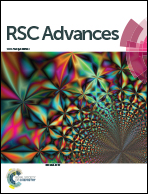Structural, transport, magnetic and magnetoelectric properties of CaMn1−xFexO3−δ (0.0 ≤ x ≤ 0.4)†
Abstract
The structural, magnetic, transport and magnetoelectric properties of parent and Fe doped CaMn1−xFexO3−δ (0.0 ≤ x ≤ 0.4) manganites are investigated using synchrotron X-ray, Raman, SQUID and nova control impedance analyzer. The Fe doped composition x = 0.3 shows a strong Maxwell–Wagner effect, and quite high positive magnetocapacitance (MC) of ∼ 8.45% at room temperature and at low magnetic field 7.8 kG has been observed. Rietveld refinement of synchrotron X-ray diffraction patterns suggests (i) a structural transformation from orthorhombic to cubic crystal system and (ii) an increase in lattice parameters with the substitution of Fe at the Mn site. Sintering at 1300 °C stabilizes the doping of higher ionic radii Fe+3 (0.645 Å)/Fe+4 (0.585 Å) atoms at the Mn+4 (0.53 Å) site in CaMn1−xFexO3−δ. The Magnetization data show a transformation of the G type of antiferromagnetic arrangement of Mn+4 electrons spins in CaMnO3 into a paramagnetic spin type arrangement with Fe substitution. The AC conductivity of the Fe doped compositions decreases more than two orders of magnitude in comparison to CaMnO3−δ.



 Please wait while we load your content...
Please wait while we load your content...